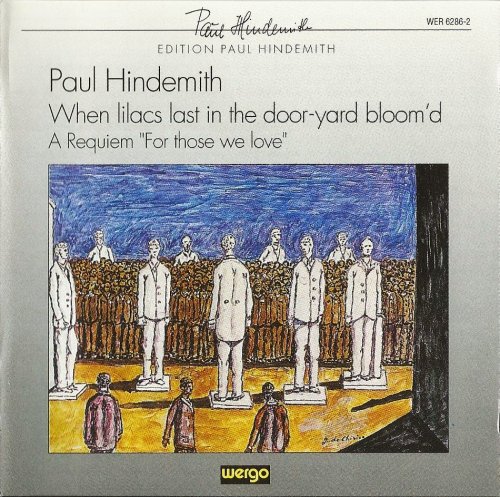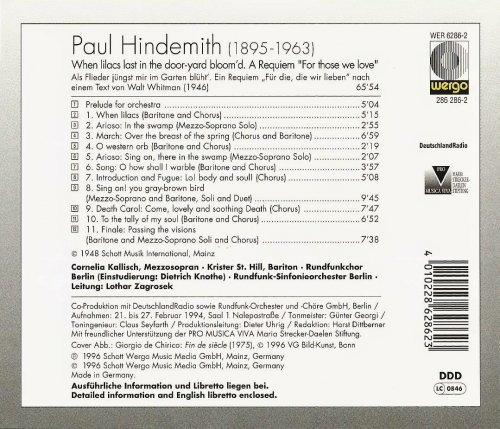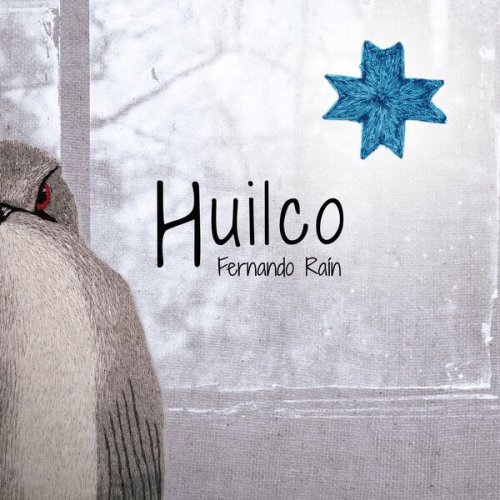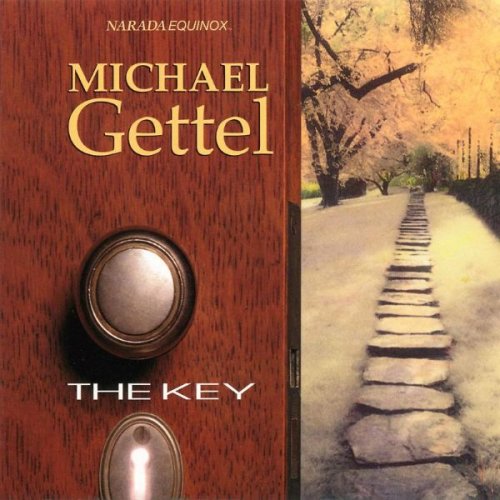Lothar Zagrosek - Hindemith: Requiem 'For those we love' (1997)

Artist: Lothar Zagrosek
Title: Hindemith: Requiem 'For those we love'
Year Of Release: 1997
Label: Wergo
Genre: Classical
Quality: FLAC (image+.cue,log,scans)
Total Time: 01:05:54
Total Size: 256 Mb
WebSite: Album Preview
Tracklist: Title: Hindemith: Requiem 'For those we love'
Year Of Release: 1997
Label: Wergo
Genre: Classical
Quality: FLAC (image+.cue,log,scans)
Total Time: 01:05:54
Total Size: 256 Mb
WebSite: Album Preview
Paul Hindemith (1895-1963)
"When lilacs in the door-yard bloom'd" - A Requiem "For those we love"
01. Prelude for orchestra [0:05:04.00]
02. 1. When lilacs [0:05:16.00]
03. 2. Arioso: In the swamp [0:02:55.57]
04. 3. March: Over the breast of the spring [0:06:59.45]
05. 4. O western orb [0:02:19.39]
06. 5. Arioso: Sing on, there in the swamp [0:02:07.29]
07. 6. Song: O how shall I warble [0:03:57.69]
08. 7. Introduction and Fugue: Lo! body and soul! [0:05:08.45]
09. 8. Sing on! you gray-brown bird [0:09:45.40]
10. 9. Death Carol: Come, lovely and soothing Death [0:07:47.50]
11. 10. To the tally of my soul [0:06:52.16]
12. 11. Finale: Passing the visions [0:07:38.45]
Performers:
Cornelia Kallisch - mezzo-soprano
Krister St. Hill - baritone
Rundfunkchor Berlin
Rundfunk-Sinfonieorchester Berlin
Lothar Zagrosek – conductor
In 1946 Hindemith, who became an American citizen in January of that year, composed the Requiem for Robert Shaw's Collegiate Chorale. Whitman's poem had been written on the death of Lincoln. Some parallel events at Roosevelt's death and the excellent interpretation presented Hindemith's work a great success.
The recent identification of the Jewish melody Gaza, which appears in large parts of the work, reveals a further meaning: It must be seen as Hindemith's musical reaction to the Holocaust, a reaction, whose effect is all the more penetrating and persuasive, because Hindemith himself never revealed the identity of the Gaza melody for the purposes of cheap publicity. Hindemith wrote a Requiem for the living (the survivors), who are obligated to remember and identify themselves with the victims and must transform this historical moment into an imperishable personal experience.
The recent identification of the Jewish melody Gaza, which appears in large parts of the work, reveals a further meaning: It must be seen as Hindemith's musical reaction to the Holocaust, a reaction, whose effect is all the more penetrating and persuasive, because Hindemith himself never revealed the identity of the Gaza melody for the purposes of cheap publicity. Hindemith wrote a Requiem for the living (the survivors), who are obligated to remember and identify themselves with the victims and must transform this historical moment into an imperishable personal experience.

![Afrodream - Guiss Guiss (2025) [Hi-Res] Afrodream - Guiss Guiss (2025) [Hi-Res]](https://www.dibpic.com/uploads/posts/2025-12/1765638325_a2717494732_0.jpg)


![Chris Connor - Free Spirits (Remastered) (2025) [Hi-Res] Chris Connor - Free Spirits (Remastered) (2025) [Hi-Res]](https://www.dibpic.com/uploads/posts/2025-12/1765538301_ccfs500.jpg)



![Machito and His Orchestra - Irving Berlin in Latin America (Remastered Edition 2025) [Hi-Res] Machito and His Orchestra - Irving Berlin in Latin America (Remastered Edition 2025) [Hi-Res]](https://www.dibpic.com/uploads/posts/2025-12/1765784965_moib.jpg)
